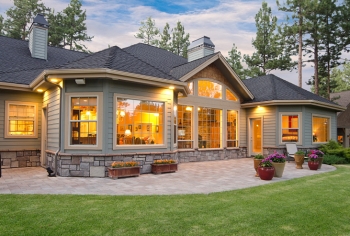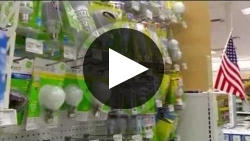
Energy-efficient indoor and outdoor lighting design focuses on ways to improve both the quality and efficiency of lighting. | Photo courtesy of ©iStockphoto.com/chandlerphoto.
Energy-efficient indoor and outdoor lighting design focuses on ways to improve both the quality and efficiency of lighting. If you're constructing a new house, consider lighting as part of your whole-house design -- an approach for building an energy-efficient home.
Indoor Lighting Design
When designing indoor lighting for energy efficiency, consider some basic design principles and methods.
Energy-efficient lighting design principles include the following:
- More light is not necessarily better: light quality is as important as quantity
- Match the amount and quality of light to the performed function
- Install task lights where needed and reduce ambient light elsewhere
- Use energy-efficient lighting components, controls, and systems
- Maximize the use of daylighting.
Here are some basic methods for achieving energy-efficient indoor lighting:
- Install fluorescent or LED light fixtures for all ceiling- and wall-mounted fixtures that will be on for more than 2 hours each day, such as kitchen and living room, bathroom, hallway, and other higher-demand locations.
- Consider installing fluorescent or LED fixtures, rather than using fluorescent or LED replacement lamps in incandescent fixtures.
- Use CFLs or LEDs in portable lighting fixtures that are operated for more than 2 hours a day.
- Use ENERGY STAR® labeled lighting fixtures.
- Use occupancy sensors for automatically turning on and off your lights as needed.
- Consider light wall colors to minimize the need for artificial lighting.
- If you are using recessed lights in a ceiling with an unconditioned space above it, use only Underwriters Laboratory (UL) approved fixtures that are airtight, are IC (insulation contact) rated, and meet ASTM E283 requirements.
Outdoor Lighting Design
When designing outdoor lighting, consider the purpose of the lighting along with basic methods for achieving energy efficiency.
Outdoor lighting for homes generally serves one or more of three purposes:
- Aesthetics: Illuminate the exterior of the house and landscape
- Security: Illuminate the grounds near the house or driveway
- Utility: Illuminate the porch and driveway to help people navigate safely to and from the house.
Here are some basic methods for achieving energy-efficient outdoor lighting:
- Security and utility lighting does not need to be bright to be effective.
- Use LED or fluorescent lights unless incandescent lights are automatically controlled to be on for just a few minutes each day.
- Consider flood lights with combined photosensors and motion sensors in the place of other security lighting options.
- Make sure outdoor light fixtures have reflectors, deflectors, or covers to make more efficient use of the light source and help reduce light pollution.
- Use timers and other controls to turn decorative lighting on and off.
- Use outdoor solar lighting where applicable.
Links
- ENERGY STAR lighting
- Find a lighting designer - International Association of Lighting Designers
- Find lighting certified professionals - National Council on Qualifications for the Lighting Professions



